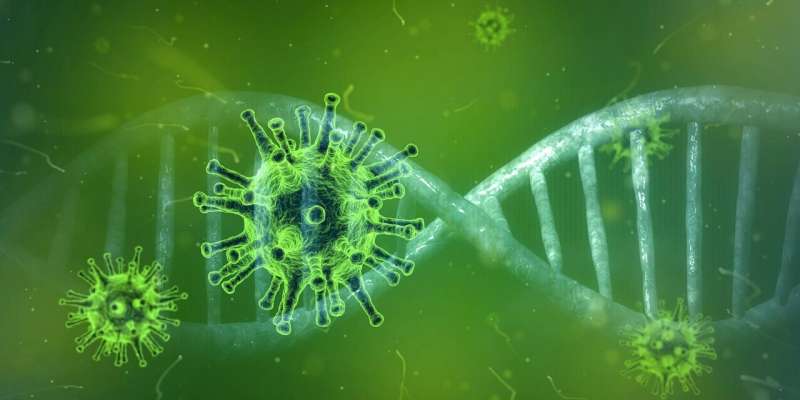Omicron genetics and early transmission patterns characterized

The omicron variant of SARS-CoV-2 diverged from previous SARS-CoV-2 variants as a result of adaptive evolution, in which beneficial mutations are passed on to future generations through natural selection, rather than through recombination between previous variants, according to a large international team of researchers. The study, which published recently in Nature, is the first to describe the genomic profile of omicron and explore the origins of the variant.
"We have seen SARS-CoV-2 generate three major variants—alpha, delta and omicron—in about 16 months, which is very surprising because other viruses do not make such repeated big evolutionary leaps," said Maciej Boni, associate professor of biology, Penn State, who led the recombination analysis for this global collaboration. "The latest variant—omicron—is extraordinary because of the even bigger jump it made in the evolution of its spike protein."
Boni noted that compared to previous variants, omicron's spike protein has more than 30 mutations, many of which are known to influence host antibody neutralization.
"Given that omicron made such a big leap forward evolutionarily speaking, we wanted to investigate why and how this may have happened," he said.
To do that, the team—which was led by the Centre for Epidemic Response and Innovation in South Africa—analyzed all 686 omicron sequences that were available by Dec. 7, 2021. They found that omicron falls within the B.1.1 lineage, which also includes the alpha variant. Interestingly, the team found that omicron is genetically distinct from alpha, as well as any other known variants of interest.
"What this means is that although omicron belongs to the same lineage as the alpha variant, it has changed to such a great extent that it is largely unrecognizable as a cousin or nephew of the alpha variant," said Boni. "When the omicron genome was first sequenced, it became clear that this virus had the potential to be phenotypically very different from previous SARS-CoV-2 variants that we were familiar with."
To determine when the omicron variant first emerged, the team used a technique, called time-calibrated Bayesian phylogenetic analysis. They estimated that the date when the most recent common ancestor of all omicrons existed was early October 2021.
Next, the team applied a selection analysis to the 686 omicron sequences and found evidence of positive natural selection in many genes since the variant split from other B.1.1 lineages. "This finding led to our conclusion that adaptive evolution played a significant role in the early emergence and establishment of omicron," said Boni. "This finding suggests that omicron is likely the result of an evolutionary process that created a highly transmissible virus that partially evades our antibody responses."
Additionally, the finding ruled out recombination of previous variants in the origin of omicron.
"We found no convincing evidence of omicron being a recombinant of previous SARS-CoV-2 variants," said Boni.
The team did find that some samples of omicron displayed weak evidence of having inherited genetic material from a delta virus, but statistical analyses could not rule out random chance or small sequencing errors as causes of this curious recombination signal.
"Given the recent misinformation suggesting that the omicron and delta variants have recombined to create a 'deltacron' super variant, it is important to note that such recombination is in fact possible, but there is currently no evidence that this has occurred," said Boni. "Additionally, if it does occur, there's no telling what the properties of such a virus would be in terms of its ability to transmit and/or cause severe disease, among other factors."
Regarding omicron's transmissibility, the team concluded that partial immune evasion was likely a major driver of the rapid spread of omicron in South Africa given that the proportion of the South African population that was immune (either from infection, vaccination or both) was above 60%.
"This idea that omicron can partially evade the immune system is supported by other recent findings showing an increased risk of SARS-CoV-2 reinfection associated with the emergence of omicron," said Boni. "We also know now that the viral load of omicron is higher in people who are infected, which also contributes substantially to its high transmission rate."
Boni noted that the current omicron wave is a reminder to all Americans to keep our COVID-19 vaccinations as current as possible.
"We can't afford to endure another calendar year with half a million deaths," he said.
More information: Raquel Viana et al, Rapid epidemic expansion of the SARS-CoV-2 Omicron variant in southern Africa, Nature (2022). DOI: 10.1038/s41586-022-04411-y





















